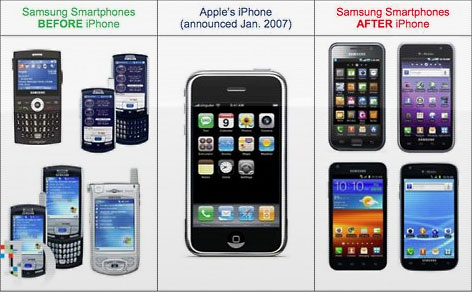Samsung isn't the first company to be stung when it has copied too
closely. Many companies follow the lead that someone else set, because
that is where consumer attention is focused. Like others before them,
they believed that adding a few small details will be enough to protect
them.
Unfortunately for Samsung, it is big enough to know better and
should have been better prepared, since Apple has a huge reputation for
litigation. Apple's own website has a huge list of
trademarks that it owns. The only thing missing is a clear
statement that Apple will attack you to the full extent of the law if
you put a single toe across the line.

Apple's image showing how the iPhone influenced Samsung smartphone
design.
Apple and Samsung may have had a good vendor/customer relationship
with Apple buying Samsung components. As Samsung started moving its
product design to match Apple, let's just say friendship ends when
money is on the line. It was obvious from day one that an Android
tablet would compete directly with the iPad, and there is no pretending
that Apple would ignore it.
Many people have been making hay out of the injunction on Samsung's
Galaxy tablet in Europe. These people are blinded by the popularity of
the iPad design as being the only option (see iPad Trade Dress Ruling in
Europe Won't End Tablet Competition). They are underreporting the
importance of the look of a product for the name brand company.
We all see trademarks everyday and understand them a little. We have
Tylenol for headaches, Ford for cars, and Google for web search. Beyond
trademarks, anything about a product can make it distinctive and
recognizable. Thinks of the Golden Arches used by McDonald's, the shape
of a Coca-Cola bottle, or the blue diamond shape of a Viagra pill.
These distinctive visual clues are protected by trade dress laws, which
are part of the overall trademark laws.
Imagine if Burger King started putting up Golden Arches outside its
restaurants. McDonald's wouldn't be happy, and a few customers would
drive up expecting to get a Big Mac. Stealing the Golden Arches is just
as bad as taking the trademark McDonald's name and using it on your own
restaurant. (Unless you are in China, where no one will notice, at
least for awhile.)
We now know that those crazy Europeans allowed Apple to create a
trade dress over the look of the iPad but think we'd be too smart for
that here in the US. Wrong, we have similar laws here, and the Supreme
Court has
this to say about trade dress: "almost anything at all that is
capable of carrying meaning" as a "symbol" or "device", terms used to
define trademarks in The Lanham Act.
The US gives the same kinds of protection as Europe, and the battle
with Samsung could impact imports here just as easily.
Are these are just frivolous lawsuits by Apple to unfairly block
Samsung from the market? Not hardly! We can look at a similar case
between two other companies to see what is at stake. In the case of
McNeil vs. Granutec, Granutec was selling a capsule that looked a
lot like Tylenol.

Tylenol's patented color scheme.
Tylenol was a red and yellow, and so was Granutec's generic
equivalent. McNeil thought they were too similar, after all with all
the possible color choices(e.g., red/green, blue/yellow, red/white,
etc.) there was no reason to use red/yellow except to match
Tylenol.
The Court found the following:
II. Irreparable Harm to the Plaintiff and Injury to
the Defendant
In the OTC drug market, brand loyalty is not a small
matter, and OTC drugs are not small business. In the gelcap's first
full year on the market, McNeil spent forty million dollars on consumer
advertising - primarily in an effort to regain the loyalty the Tylenol
brand lost when its capsules were tampered with. McNeil's Prop.
findings of Fact and Concl. of Law at 13. The red and [*204] yellow
capsule-shaped gelcap thereafter became McNeil's top selling Tylenol
product.
Because of the history behind the Tylenol gelcap,
e.g., the tampering incidents with the capsule and the subsequent
marketing blitz for the gelcap, Granutec's copying of the gelcap's
shape, texture, and color combination is particularly troublesome to
McNeil. McNeil has taken great pains in the last seven years to regain
public confidence in the Tylenol name, and the Tylenol gelcap appears
to have obtained strong name brand recognition and quite a large
following. To permit Granutec to indistinguishably copy McNeil's red
and yellow gelcap not only allows Granutec to benefit from Tylenol's
name brand recognition and faithful following, but also takes [**15]
away McNeil's control over its reputation and goodwill.
There can be no doubt that Apple spends just as much on advertising
the iPad as McNeil did for Tylenol. And if Samsung's tablet is too
similar to the iPad, then brand recognition and faithful following is
not something they should be allowed to take away from Apple.
There are millions of possible changes that Samsung could have made
- different color, edge details, contours, raised surfaces, buttons,
bezels, etc. A more thought out design could have distinguished
Samsung's product from the iPad. Apple is not to blame in this
situation.
Samsung can easily fix the problem with a few changes. It will cost
time and money, but they will soon be back on the market. While some
may think its not possible, Samsung could even come up with a better
design that gets Apple imitating it. Sure, this isn't likely given
their copycat attitude, but it is possible.





